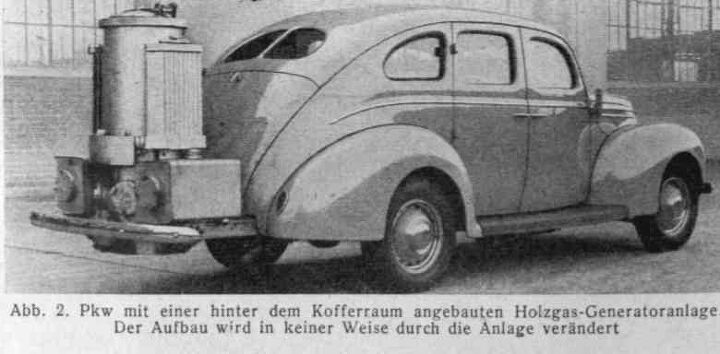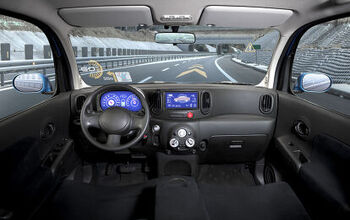Rolling [Gasified] Coal: Gas Bag Vehicles

The autoblogosphere is abuzz with the topic of “ rolling coal“, apparently the practice of some diesel pickup truck enthusiasts who fiddle with their fuel systems so as to produce voluminous clouds of dense black, sooty exhaust smoke. I have to admit that when I first saw the phrase “rolling coal” in a headline at Jalopnik I thought it had something to do coal gasification and running cars on wood gas or syngas. After finding out that rolling coal wasn’t what I thought it was, I did look into the history of powering motor vehicles on wood gas and ended up finding out about these rather odd looking cars and trucks known as gas bag vehicles. Frankly they’re more interesting to me than whether or not pickup truck driving bros are blowing smoke in the faces of Prius drivers. I believe that you’ll find these vehicles interesting as well.
The process of using oxygen starved combustion to turn organic material into a combustible gas has been known for 175 years. Gustav Bischof built the first wood gasifier in 1839. By the turn of the 20th century, before the use of natural gas started proliferating in the 1930s, in many municipalities syngas produced from coal was centrally produced and distributed via pipelines to homes and businesses to use for heating and cooking. In 1901, Thomas Parker made the first vehicle powered by wood gas.
The best known use of wood gas and syngas to power vehicles, however, was in Germany during World War II.
Germany was heavily dependent on petroleum mined outside of the country’s borders so gasoline and diesel fuel were rationed for the civilian population in order to reserve those fuels for military use. Germany may have had little petroleum but it had a lot of domestic coal.
Considerable effort was also put into industrial scale production of synthetic fuels and lubricants using the the Fischer-Tropsch method. It’s estimated that 9% of the Reich’s liquid fuel and a quarter of the automotive fuels used during the war were synthetics made from coal.
In addition to commercial scale synthetic fuel production, by the end of the war there were about a half million German cars, trucks, buses, tractors, motorcycles, and even marine ships and railroad locomotives that were equipped with portable wood gasifiers. Wood gas powered vehicles were also common elsewhere in wartime Europe.
The widespread use of synthetic gas to run cars and trucks dates to another war, though, World War One. As mentioned, many cities distributed what was known as “town gas” or “street gas”, a byproduct of making coal into the cokes that are used to refine iron.
During the first world war, some creative folks in France, the Netherlands, Germany and the United Kingdom figured out that they could run their motor vehicles, like Thomas Parker did, on that gaseous fuel rather than on gasoline, which was in short supply due to the ongoing hostilities.
One of the barriers facing modern day gaseous fueled vehicles is that compressed natural gas (CNG) or liquified petroleum gas (LPG) have lower energy densities than gasoline so the tanks for the compressed gas end up being about twice the size of a conventional liquid fuel tank. “Town gas” has an even lower energy density than CNG or LPG. At normal atmospheric pressure, the town gas equivalent to a liter of gasoline takes up between two and three cubic meters of volume.
While today CNG vehicle operators can buy commercial and even home gas compressors, a century ago such compressors weren’t readily available. Also, syngas is made up of carbon monoxide and hydrogen. Though it was possible to compress town gas, it wasn’t practical. Carbon monoxide breaks down when compressed and the steel tanks of the day could not contain hydrogen gas without leaking.
The solution was to store the syngas in large inflatable bags, essentially balloons, made of coated fabric, that were mounted on the roofs of the vehicles. It was obviously more practical for larger vehicles, like trucks and buses, but some automobile owners made the conversion as well. Some of the commercial conversions included fairings and bodywork to hide the bags and provide some aerodynamic improvement (back then it would have been called “streamlining”), and a place for advertising, but in most cases the vehicles looked like they were hauling around bales of cotton, well, until the bags deflated as the gas was consumed. Some owners built metal or wooden frameworks to contain and protect the fuel bladders, which were made of rubber coated silk or other fabric material. If they sprung a leak, they were repaired with a patch for a bicycle tire tube.
Because of the lack of energy density, gas bag vehicles were strictly for short range driving. With consumption of 13 liters of gas per kilometer, the equivalent of 22 mpg with gasoline, a 13 cubic meter gas bag would give a range of about 50 km (~30 miles). It’s possible that some drivers fitted some kind of fuel gauge, but apparently most just watched their fuel tank deflate. The vehicles could be refueled wherever town gas was supplied.
The main drawbacks to the gas bag vehicles were fire risk, bridges and the fact that your fuel tank might blow away if you went too fast. Passengers waiting at bus stops were warned not to smoke.
“Rauchen verboten” – smoking was forbidden at bus stops due to fire risk from gas bag leaks.
Drivers had to plan for overpasses and other potential overhead obstacles and were urged not to exceed 30 mph, both to preserve range and to keep the gas bag secured to the vehicle. Sidewinds were also a problem.
Despite their drawbacks, gas bag vehicles’ use has not been restricted to wartime. Because the fuel is an inexpensive byproduct of industrial processes the city of Chongqing, China developed gas bag buses as a cost effective public transportation solution in the 1960s and gas bag buses stayed in operation in China into the 1990s.
Ronnie Schreiber edits Cars In Depth, a realistic perspective on cars & car culture and the original 3D car site. If you found this post worthwhile, you can get a parallax view at Cars In Depth. If the 3D thing freaks you out, don’t worry, all the photo and video players in use at the site have mono options. Thanks for reading – RJS

Ronnie Schreiber edits Cars In Depth, the original 3D car site.
More by Ronnie Schreiber
Latest Car Reviews
Read moreLatest Product Reviews
Read moreRecent Comments
- Bd2 Ultimately, it comes down to price/whether it makes financial sense for buyers (right now, BEVs just aren't there, even with the tax credit). HEVs are finally seeing their place in the sun, decades after being a niche market; this is due to premium for HEVs having narrowed significantly with pure ICE, whereby buyers can recoup that after 2-3 years of ownership.
- MaintenanceCosts I've experienced three cars that were the first year of the model. The two I bought (first-off-the-boat 2004 TSX and midyear 2006 Civic) were both Hondas and were both flawless. The other one was my ex-stepmother's 1990 Land Rover Discovery. It was one of the very first Euro-spec models, a two-door with an asthmatic carbureted 3.5L V8 and a five-speed manual. Every part of the car broke at some point, including things like hatch hinges that really shouldn't break. It turned her off Land Rover forever, and her cars since have all been Subarus.
- MaintenanceCosts When I was living with my Bolt in a rental condo and charging from 120V in the garage, as soon as the association figured out what was happening, they asked me to pay $30 a month to cover the cost. That's pretty close to what I was using so I had no issue with it.
- SCE to AUX I've had mixed results with first-year cars:71 Pinto - good. 85 LeBron GTS - good. 96 Grand Voyager - good. 02 Passat B5.5 - bad. 05 Odyssey - bad. I also had a last-year car that was terrible (80 Bobcat), but most cars were crap then, anyway.
- Crown Go big or go home. Never understood the "economy version" that manufacturers make of a performance car.

















































Comments
Join the conversation
I had never heard of gas bag vehicles before. This is why I love this site, you learn something new nearly every day. On a sidenote, one of my co-workers has a woodgas carburetor in his pickup truck. Say what you will, but it's pretty amazing to actually see a car running with firewood as fuel.
Very interesting! I didn't know this existed at all.